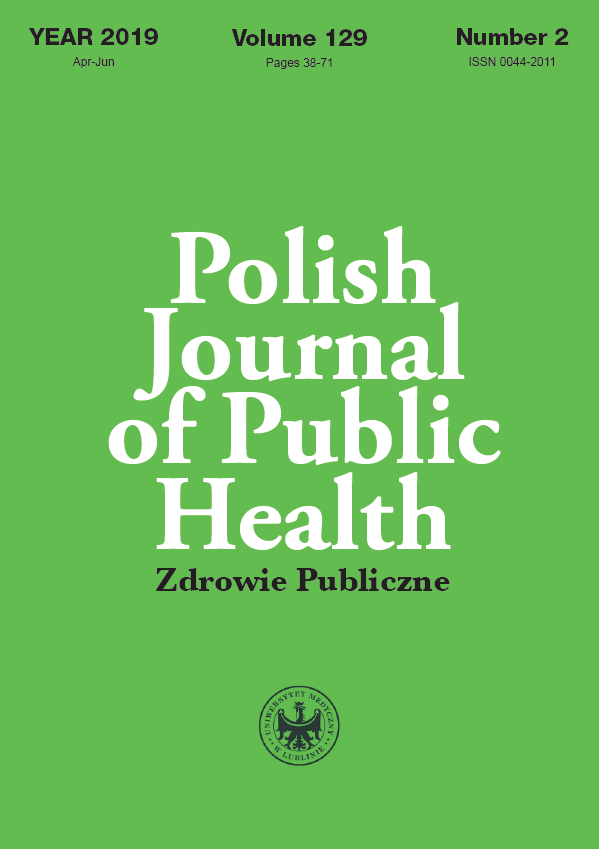The influence of the sensitivity of the trapezius muscle on the changes within the bioelectric tensions of the masticatory muscles
DOI:
https://doi.org/10.2478/pjph-2019-0012Keywords:
sEMG, pressure pain threshold, trapezius muscle, TMDAbstract
Introduction. Pathological muscle tone can cause changes in the facial skeleton, including tension headaches, tinnitus, temporomandibular joint dysfunctions. The complexity of pathologies and their spectrum may also indicate changes beyond the facial skeleton. The aim of the study was to determine the possible correlation between the pressure pain threshold of the trapezius muscle and the bioelectrical tension on the masticatory muscles.
Aim. The aim of the study was to determine the possible correlation between the pressure pain threshold of the trapezius muscle and the bioelectric tension on the masticatory muscles.
Material and methods. The number of 36 women applied for the study. They were all examined using an algometer within a trapezius muscle to determine the pressure pain threshold. The electromyographic study was carried out in accordance with the SENIAM guidelines. The resting activity of selected masticatory muscles (temporal and masseter) was recorded for 10 sec. The study involved an 8-channel BioEMG IIITM surface electromyography apparatus with BioPak Measurement System (BioResearch Associates, Inc. Milwaukee, WI, USA). Statistical analysis was carried out using the r-Pearson test. The level of significance was set at 5%.
Results. After comparing the bioelectric tension of the masticatory muscles and the pressure pain threshold, left-sided correlation was observed (p<0.05). Both in the right-hand and general comparison, the results did not reach the required level of statistical significance (p>0.05).
Conclusions. The pressure pain threshold seems to be linked to the bioelectrical muscle tone of the masticatory muscles. To confirm this observation, further research into a larger and more diverse group of participants is recommended.
References
1. Ferrante T, Manzoni GC, Russo M, et al. Prevalence of tension-type headache in adult general population: the PACE study and review of the literature. Neurol Sci. 2013;34(Suppl. 1):137-8.
2. Zieliński G, Suwała M, Ginszt M, et. The relationship between masticatory muscles activity and tinnitus – preliminary study. Fam Med Primary Care Rev. 2019;21:66-9.
3. Zieliński G, Suwała M, Ginszt M, et al. Bioelectric activity of mastication muscles and the functional impairment risk groups concerning the masticatory muscles. Acta Bioeng Biomech. 2018;20(4):161-6.
4. King CD, Mano KEJ, Barnett KA, et al. Pressure pain threshold and anxiety in adolescent females with and without Juvenile Fibromyalgia: a pilot study. Clin J Pain. 2017;33:620-6.
5. Llamas-Ramos R, Pecos-Martín D, Gallego-Izquierdo T, et al. Comparison of the short-term outcomes between trigger point dry needling and trigger point manual therapy for the management of chronic mechanical neck pain: a randomized clinical trial. J Orthop Sports Phys Ther. 2014;44:852-61.
6. Chatchawan U, Thongbuang S, Yamauchi J. Characteristics and distributions of myofascial trigger points in individuals with chronic tension-type headaches. J Phys Ther Sci. 2019;31:306.
7. Moloney TM, Witney AG. Pressure pain thresholds increase after preconditioning 1 Hz repetitive transcranial magnetic stimulation with transcranial direct current stimulation. PLoS ONE. 2014;9:e92540.
8. Wieczorek A, Loster J, Loster B, et al. Correlation between activity and asymmetry indices and skeletal classes in symptomatic-free young adults. J Stomatol. 2013;66:750-60.
9. Okeson JP, Drobek W. Leczenie dysfunkcji narządu żucia i zaburzeń zwarcia. Lublin: Wydawnictwo Czelej; 2005.
10. Ritzel CH, Diefenthaeler F, Rodrigues AM, et al. Temporomandibular joint dysfunction and trapezius muscle fatigability. BJPT. 2007;11:333-9.
11. Gawda P, Michalik J, Ginszt M, et al. Assessment of the efficacy of trigger point therapy of the trapezius muscle using superficial electromyography in patients with temporomandibular joint pain. Orthod Forum. 2016;12:8- 14.
12. Schleip R, Saulicz E, Findley TW, et al. Powięź: badanie, profilaktyka i terapia dysfunkcji sieci powięziowej. Wrocław: Edra Urban & Partner; 2016.
13. Stecco L, Poncyljusz P, Stecco C. Manipulacja powięzi w zespołach bólowych układu ruchu: część praktyczna. Szczecin: Wydawnictwo Odnowa; 2015.
Downloads
Published
Issue
Section
License
Copyright (c) 2019 Polish Journal of Public Health

This work is licensed under a Creative Commons Attribution-NonCommercial-NoDerivatives 3.0 Unported License.


